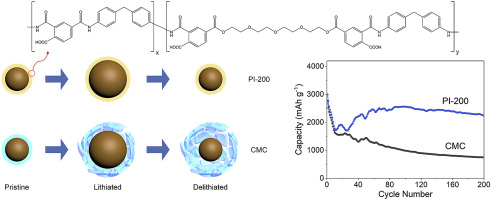Journal of Power Sources ( IF 9.2 ) Pub Date : 2018-01-12 , DOI: 10.1016/j.jpowsour.2017.12.086 Dahua Yao , Yu Yang , Yonghong Deng , Chaoyang Wang

|
A series of polyimides, which contain polyethylene glycol (PEG) segments with different molecular weight in the polymer chains, are synthesized through a facile one-pot method and characterized by Fourier transform infrared spectroscopy and hydrogen nuclear magnetic resonance spectroscopy. The main part of polyimides is originated from trimellitic anhydride chloride (TMAC) and 4,4′-methylenedianiline, onto which PEG segments are introduced through an esterification reaction with TMAC. These obtained polyimides, which acquire excellent water solubility after being neutralized by triethylamine, are applied as water-soluble binders to silicon negative electrodes for lithium ion batteries, and significantly improve the electrochemical performance of silicon anodes. Specially, the PI-200 (polyimide copolymerized with PEG-200) based silicon electrode exhibits a high initial discharge capacity of 2989.7 mAh g−1 and remains about 2235.5 mAh g−1 after 200 cycles at the current density of 0.1 C (420 mA g−1).
中文翻译:

通过一锅法合成的柔性聚酰亚胺,作为锂离子电池中硅阳极的水溶性粘合剂
通过一种简便的一锅法合成了一系列聚酰亚胺,这些聚酰亚胺在聚合物链中包含具有不同分子量的聚乙二醇(PEG)链段,并通过傅里叶变换红外光谱和氢核磁共振光谱进行了表征。聚酰亚胺的主要部分来自偏苯三甲酰氯(TMAC)和4,4'-亚甲基二苯胺,通过与TMAC的酯化反应在其上引入PEG片段。这些获得的聚酰亚胺在被三乙胺中和后具有优异的水溶性,将它们作为水溶性粘合剂应用于锂离子电池的硅负极,并显着改善了硅阳极的电化学性能。特别,-1并在0.1 C(420 mA g -1)的电流密度下经过200次循环后仍保持约2235.5 mAh g -1。



























 京公网安备 11010802027423号
京公网安备 11010802027423号